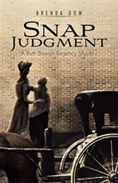"There is a man lying out there—behind the counter. I think he is dead."

 |
Snap Judgment by Brenda Dow Trafford Publishing
book review by Cynthia Collins
The story unfolds in the family-owned shop of Bowen & Sons Watchmakers in London in 1817. A wealthy young woman walks in and purchases a watch. She hands a piece of paper to the engraver with the inscription she wants on it. After she leaves, Michael Bowen steps out of the shop and sees a street fight going on around a sedan chair. The young woman gets out of the chair and Michael helps her to safety.
In a seemingly unrelated incident, Michael's stepmother, Ruth Bowen, and his younger brother are scheduled to return to London after visiting her parents. Ruth had not seen them since their disapproval of her marriage into a Quaker family. Now that she is a widow, this visit was a reconciliation. As the mail coach pulls away to return to London, she sees a man she recognizes talking to her younger sister. She jumps out of the coach to warn her, leaving her stepson to make the journey without her.
When Ruth finally returns to the shop in London, she goes behind the counter and discovers a man had been stabbed. Through many twists and turns, individual secrets come out in the open, her stepson is arrested for murder, and the young woman in the opening scene, Thalia Holland, plays a prominent role throughout the story.
The author has written several books that center around the same main character. Ruth Bowen is an active woman who is curious about getting to the bottom of mysterious events. She and Thalia are strong characters, independent, and intelligent. Ruth's search for the truth takes her from the wealthy upper classes to stark prisons as she pursues finding the real killer. The plot moves forward with just enough description to set the scene. The personality of each character is well-defined and the author's knowledge of social customs, legal custom,s and the dark streets of London during the early 19th century is apparent. The clues used to solve the crime, without modern technology, add to the intrigue.
RECOMMENDED by the US Review